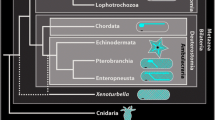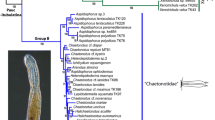Abstract
Echinoderms are a key group in understanding the evolution of the nervous system in the Metazoa. Remarkably, little is known about echinoderm neurobiology. The echinoderm podia, which are unique echinoderm modifications and comprise structures responsible for locomotion and feeding, have been largely neglected in nervous system studies. Here, we have applied immunohistological approaches using different neuronal markers to describe the neuroanatomy of the holothurian podia and its relation to the muscular component. We show, using the sea cucumber Holothuria glaberrima (Selenka, 1867), the direct innervation of the podia by the ectoneural component of the nervous system, as well as the existence of a connection between the nervous system components in the main nerves, the muscle, and the connective tissue. These findings confirm the ectoneural origin of the tube feet’s main nervous system and demonstrate its neuroanatomic complexity. We also show the presence of fibers and neurons within the tube feet mesothelium and connective tissue. The study of these simple structures will help us elucidate the echinoderms’ neuromuscular circuit and their evolutionary relationships.








Similar content being viewed by others
References
Birenheide R, Motokawa T (1996) Contractile connective tissue in crinoids. Biol Bull 191:1–4
Birenheide R, Tamori M, Motokawa T, Ohtani M, Iwakoshi E, Muneoka Y, Fujita T, Minakata H, Nomoto K (1998) Peptides controlling stiffness of connective tissue in sea cucumbers. Biol Bull 194:253–259
Bouland C, Massin C, Jangoux M (1982) The fine structure of the buccal tentacles of Holothuria forskali (Echinodermata, Holothuroidea). Zoomorphology 101:133–149
Burke RD, Osborne L, Wang D, Murabe D, Yaguchiand S, Nakajima Y (2006a) Neuron-specific expression of a synaptotagmin gene in the sea urchin Strongylocentrotus purpuratus. J Comp Neurol 496:244–251
Burke R, Angerer L, Elphick M, Humphrey G, Yaguchi S, Kiyama T, Liang S, Mu X, Agca C, Klein W, Brandhorst B, Rowe M, Wilson K, Churcher A, Taylor J, Chen N, Murray G, Wang D, Mellott D, Olinski R, Hallböök F, Thorndyke M (2006b) A genomic view of the sea urchin nervous system. Dev Biol 300:434–460
Cavey MJ (2006) Organization of the coelomic lining and a juxtaposed nerve plexus in the suckered tube feet of Parastichopus californicus (Echinodermata: Holothuroida). J Morphol 267:41–49
Cavey MJ, Wood RL (1981) Specializations for excitation–contraction coupling in the podial retractor cells of the starfish Stylasterias forreri. Cell Tissue Res 218:475–485
Cobb JLS (1987) Neurobiology of the echinodermata. In: Ali MA (ed) Invertebrate nervous systems. Plenum Press, New York, pp 483–525
Díaz-Balzac CA, Santacana-Laffitte G, San Miguel-Ruíz JE, Tossas K, Valentín-Tirado G, Rives-Sánchez M, Mesleh A, Torres II, García-Arrarás JE (2007) Identification of nerve plexi in connective tissues of the sea cucumber Holothuria glaberrima by using a novel nerve-specific antibody. Biol Bull 213(1):28–42
Díaz-Miranda L, Blanco RE, García-Arrarás JE (1995) Localization of the heptapeptide GFSKLYFamide in the sea cucumber Holothuria glaberrima (Echinodermata): a light and electron microscope study. J Comp Neurol 352:626–640
Díaz-Miranda L, Pardo-Reoyo CF, Martínez R, García-Arrarás JE (1996) Galanin-like immunoreactivity in the sea cucumber Holothuria glaberrima. Cell Tissue Res 286:385–391
Flammang P, Jangoux M (1992) Functional morphology of the locomotory podia of Holothuria forskali (Echinodermata: Holothuroida). Zoomorphology 111:167–178
Florey E, Cahill MA (1977) Ultrastructure of sea urchin tube feet. Evidence for connective tissue involvement in motor control. Cell Tissue Res 177:195–214
Florey E, Cahill MA (1982) Scanning electron microscopy of echinoid podia. Cell Tissue Res 224:543–551
García-Arrarás JE (1993) Localization of peptides: double labeling immunohistochemistry. In: De Pablo F, Scanes C, Weintraub B (eds) Handbook of endocrine research treatment. Academic Press, San Diego, pp 207–225
García-Arrarás JE, Díaz-Miranda L, Torres II, File S, Jiménez LB, Rivera-Bermudez K, Arroyo EJ, Cruz W (1999) Regeneration of the enteric nervous system in the sea cucumber Holothuria glaberrima. J Comp Neurol 406(4):461–475
García-Arrarás JE, Rojas-Soto R, Jiménez LB, Díaz-Miranda L (2001) The enteric nervous system of echinoderms: unexpected complexity revealed by neurochemical analysis. J Exp Biol 204:865–873
Humason GL (1979) Animal tissue techniques. WH Freeman & Co, San Francisco
Hyman LH (1955) The invertebrates: echinodermata, vol 4. McGraw-Hill, New York
Inoue M, Birenheide R, Koizumi O, Kobayakawa Y, Muneoka Y, Motokawa T (1999) Localization of the neuropeptide NGIWYamide in the holothurian nervous system and its effects on muscular contraction. Proc R Soc B 266:993–1000
Mashanov S, Dolmatov IY (2000) Developmental morphology of a holothurian Cucumaria japonica (Dendrochirota, Holothuroidea), a species with accelerated metamorphosis. Invertebr Reprod Dev 37(2):137–146
McKenzie JD (1987) The ultrastructure of the tentacles of eleven species of dendrochirote holothurians studied with special reference to the surface coats and papillae. Cell Tissue Res 248:187–199
Moore S, Thorndyke MC (1993) Immunocytochemical mapping of the novel echinoderm neuropeptide SALMFamide 1 (S1) in the starfish Asterias rubens. Cell Tissue Res 274:605–618
Motokawa T (1984) Connective tissue catch in echinoderms. Biol Rev 59:255–270
Nakajima Y, Kaneko H, Murray G, Burke RD (2004) Divergent patterns of neural development in larval echinoids and asteroids. Evol Dev 6:95–104
Pentreath VW, Cobb JLS (1972) Neurobiology of the echinodermata. Biol Rev 47:363–392
Quiñones JL, Rosa R, Ruiz DC, García-Arrarás JE (2002) Extracellular matrix remodeling and metalloproteinase involvement during intestine regeneration in the sea cucumber Holothuria glaberrima. Dev Biol 250:181–197
Rieger RM, Lombardi J (1987) Ultrastructure of coelomic lining in echinoderm podia: significance for concepts in the evolution of muscle and peritoneal cells. Zoomorphology 107:191–208
Santos R, Haesaerts D, Jangoux M, Flammang P (2005) The tube feet of sea urchins and sea stars contain functionally different mutable collagenous tissues. J Exp Biol 208:2277–2288
Sea Urchin Genome Sequencing Consortium (2006) The genome of the sea urchin Strongylocentrotus purpuratus. Science 314:941–952
Smiley S (1994) Holothuroidea. In: Harrison FW, Chia FW (eds) Microscopic anatomy of invertebrates, vol 14. Echinodermata, Wiley-Liss, pp 401–471
Tamori M, Saha AK, Matsuno A, Noskor SC, Koizumi O, Kobayakawa Y, Nakajima Y, Motokawa T (2007) Stichopin-containing nerves and secretory cells specific to connective tissues of the sea cucumber. Proc R Soc Lond B 274(1623):2279–2285
Wood RL, Cavey MJ (1981) Ultrastructure of the Coelomic Lining in the Podium of the Starfish Stylasterias forreri. Cell Tissue Res 218:449–473
Acknowledgments
This work was supported by NSF (IBN-0110692) and NIH-MBRS (S06GM08102). CADB was funded by the UPR-RP MARC Program (5T34GM007821). We also acknowledge partial support from NIH-RCMI (RRO-3641-01) and the University of Puerto Rico. We would like to thank Dr. Vladimir Mashanov for critical reading of the manuscript and Dr. Eduardo Rosa-Molinar and his laboratory members for their cooperation and advice on histological techniques.
Author information
Authors and Affiliations
Corresponding author
Rights and permissions
About this article
Cite this article
Díaz-Balzac, C.A., Abreu-Arbelo, J.E. & García-Arrarás, J.E. Neuroanatomy of the tube feet and tentacles in Holothuria glaberrima (Holothuroidea, Echinodermata). Zoomorphology 129, 33–43 (2010). https://doi.org/10.1007/s00435-009-0098-4
Received:
Revised:
Accepted:
Published:
Issue Date:
DOI: https://doi.org/10.1007/s00435-009-0098-4




